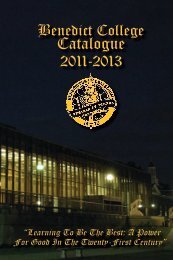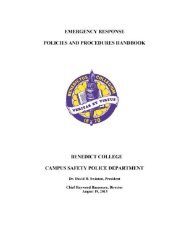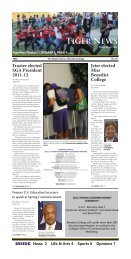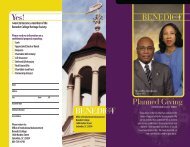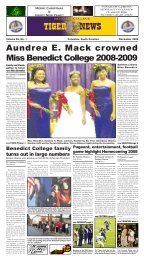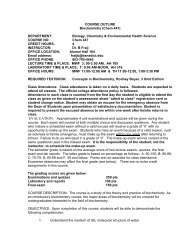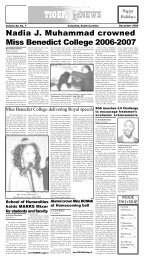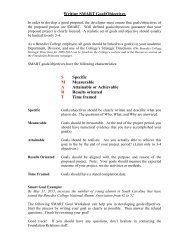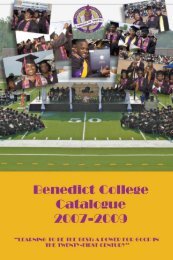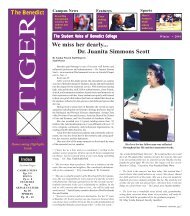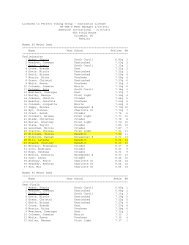Strategic Plan 2007 - Benedict College
Strategic Plan 2007 - Benedict College
Strategic Plan 2007 - Benedict College
Create successful ePaper yourself
Turn your PDF publications into a flip-book with our unique Google optimized e-Paper software.
<strong>Benedict</strong> <strong>College</strong><br />
National Alumni<br />
Association<br />
STRATEGIC PLAN<br />
<strong>2007</strong> - 2012
<strong>Benedict</strong> <strong>College</strong><br />
National Alumni<br />
Association<br />
STRATEGIC PLAN<br />
<strong>2007</strong> - 2012
Foreward<br />
<strong>Benedict</strong> <strong>College</strong> National<br />
Alumni Association <strong>Strategic</strong> <strong>Plan</strong><br />
Beginning in May, 2006, the <strong>Strategic</strong> <strong>Plan</strong>ning<br />
Committee (SPC), organized by the <strong>Benedict</strong> <strong>College</strong><br />
National Alumni Association President Elect, Sheryl<br />
Good, initiated the process to develop a strategic plan<br />
that would elevate the BCNAA to the next level. Elsie<br />
King Hamler was tapped to chair this committee with<br />
the able assistance of Jasper Salmond as co-chair. The<br />
two led a very capable group of prestigious alumni in<br />
the development of a <strong>Strategic</strong> <strong>Plan</strong> for the <strong>Benedict</strong><br />
<strong>College</strong> National Alumni Association.<br />
<strong>Strategic</strong> <strong>Plan</strong>ning Committee<br />
James Alston, ‘67 Tiara Bryant, ‘03<br />
Sheryl Good, ‘89 Walter Good, ‘71<br />
National President<br />
Elsie King Hamler, ‘71 Mary Jones, ‘68<br />
Chair<br />
Moses Mims, ‘68 Jasper Salmond, ‘54<br />
Co-Chair<br />
Julian Shabazz, ‘90 Frances Wimberly, ‘68<br />
Staff<br />
The Alumni Affairs Office, under the direction of Ada Brown Belton,<br />
'75, assisted and provided assistance in the gathering of certain<br />
information and data required by the Committee. They also facilitated<br />
the mail-outs of the surveys. Jesse Bellinger in the Office of<br />
Institutional Effectiveness, determined the statistical sample based<br />
on the total population and compiled the report summary analysis<br />
of the survey conducted.
Introduction<br />
For over 60 years the <strong>Benedict</strong> <strong>College</strong> National Alumni<br />
Association (BCNAA) has worked diligently to best serve<br />
alumni and friends of <strong>Benedict</strong> <strong>College</strong>, a Historically<br />
Black <strong>College</strong> in Columbia, South Carolina. Today, with<br />
approximately 12,000 graduates, the BCNAA has established<br />
alumni clubs across the nation to provide support<br />
to the <strong>College</strong>.<br />
Our success has been built not only by the hard work<br />
and dedication of thousands of proud <strong>Benedict</strong> alumni<br />
and friends, but also through the sensible planning of<br />
forward-thinking leaders. Our strengths provide a foundation<br />
on which we now build a new model for service<br />
to alumni and to our alma mater.<br />
In a time of unstable economic conditions, we will seek<br />
more alumni involvement in volunteering and financial<br />
support. The goodwill fostered by the BCNAA conditions<br />
alumni to serve the <strong>College</strong> in a multitude of ways.<br />
Grassroots advocacy efforts garner increased community<br />
support. Alumni recruitment efforts help the <strong>College</strong><br />
achieve its enrollment goals. And an increased membership<br />
base will enable the BCNAA to continue a level<br />
of philanthropy unmatched in Historically Black <strong>College</strong>s<br />
and Universities.<br />
The <strong>2007</strong>-2012 strategic plan of the BCNAA was developed<br />
through a collaborative effort of the BCNAA<br />
<strong>Strategic</strong> <strong>Plan</strong>ning Committee, alumni and college<br />
administrators. Driving this plan is our vision to be widely<br />
regarded as the best and the most ambitious alumni<br />
organization in America.
The <strong>Benedict</strong> <strong>College</strong> National Alumni Association<br />
Strengths, Weakness, Opportunities, and Threats Analysis<br />
STRENGTHS<br />
1. Confidence in the continuity and performance of the established leadership of the Office of Alumni Affairs.<br />
2. Excellent support and cooperation from the Board of Trustees, President of the <strong>College</strong>, and other senior<br />
administrators, including deans.<br />
3. The ability to capitalize on <strong>Benedict</strong> <strong>College</strong>'s outstanding reputation and visibility.<br />
4. A staff that is passionate, enthusiastic, professional, and hard working.<br />
5. The passion and dedication of our lead volunteers, especially BCNAA and the BCNAA’s Executive Committee.<br />
6. A strong BCNAA brand name, which heightens visibility in South Carolina.<br />
WEAKNESSES<br />
1. A proclivity for trying to meet all the demands on the BCNAA from the <strong>College</strong> and its components<br />
in the face of limited resources.<br />
2. The lack of an information technology infrastructure capable of handling large volumes of alumni details and user activity.<br />
3. Historical inability to make bold major changes to existing policies and practices.<br />
4. Lack of resources which would enable the BCNAA to move forward rather than maintain the status quo.<br />
OPPORTUNITIES<br />
1. Opportunity to engage the entire alumni population.<br />
2. Opportunities to engage alumni in ways that are non-sports oriented. The new set-up for Alumni Outreach and the<br />
alumni travel office will enable us to provide unique, educational, and fun excursions to our alumni and donors.<br />
3. Implementation of a new database system which will provide the opportunity for substantial enhancement to our<br />
membership solicitations, events tracking, stewardship, mentorship, and communication processes.<br />
4. A large and loyal natural constituency to build on for further support.<br />
5. The opportunity to engage the student base while they are on campus.<br />
6. The opportunity to explore the idea of an Alumni Center-a place for alumni to visit and receive pertinent information<br />
on events, accomplishments, other alumni, etc.<br />
THREATS<br />
1. The continuing challenge to deal with issues of accountability, value, and stewardship to our various publics.<br />
The public continues to be skeptical of the rising cost of higher education and the return on investment to<br />
student consumers.<br />
2. Changing demographics. Studies indicate that baby boomers, an increasing percentage of our alumni, are not as<br />
charitable with time or financial resources as previous generations. Outreach to younger alumni and an increasing<br />
population of diverse alumni is vital.<br />
3. Increased competition for funding, membership, and staff from the proliferation of non-profit organizations.<br />
4. Reduced appropriation and lack of understanding of <strong>Benedict</strong> <strong>College</strong>'s funding model.<br />
5. The political/economic environment. The uncertainty of world affairs and a recovering but less-than-robust<br />
economic climate has led to a cautious approach to philanthropy, membership, and volunteer involvement.
Overview of <strong>Strategic</strong> <strong>Plan</strong><br />
The BCNAA developed a <strong>Strategic</strong> <strong>Plan</strong> which contains information based on feedback using various<br />
methodologies. This collaboration with alumni, administrators, other colleges and universities, and the<br />
general community helped to further develop the strategies and action steps necessary to obtain the<br />
goals and objectives identified in the <strong>Plan</strong>. The <strong>Strategic</strong> <strong>Plan</strong> consists of the following components:<br />
1. Vision Statement<br />
2. Mission Statement<br />
3. Goals<br />
4. Action Steps<br />
5. Rationale<br />
This format outlines the tactical direction that has been determined by the BCNAA to accomplish the<br />
national agenda. The input and guidance provided within this document and its level of utilization will<br />
help shape the organization’s future and ultimately determine its success.<br />
Vision Statement of the <strong>Benedict</strong> <strong>College</strong> National Alumni Association<br />
“The BCNAA will be a diverse group whose membership is representative of alumni regardless of their<br />
age, economic status, geographical location, or gender and will have an organizational structure that will<br />
support its membership and <strong>Benedict</strong> <strong>College</strong>. This group will make a significant impact to <strong>Benedict</strong><br />
<strong>College</strong> by being a major financial contributor, recruiter of the best and brightest students, provider of<br />
scholarships, and supporter of the <strong>College</strong>’s mission.”<br />
Mission Statement of the <strong>Benedict</strong> <strong>College</strong> National Alumni Association<br />
“To strengthen the BCNAA and increase participation in and by <strong>Benedict</strong> <strong>College</strong> Alumni through<br />
increased individual membership in the BCNAA (to include lifetime memberships) and increase total<br />
alumni donor participation and annual contributions.”<br />
Goals<br />
1. Communication: Increase alumni<br />
communication and interaction with the<br />
<strong>College</strong>.<br />
2. Organizational Structure: Develop<br />
an organizational structure that provides<br />
quality service to its membership and<br />
the <strong>College</strong>.<br />
3. Membership: Increase the percentage<br />
of alumni who are active BCNAA<br />
members by 10% each year.<br />
4. Financial: Increase the annual giving<br />
of alumni by 15% each year.<br />
5. Promote Alumni: Promote the<br />
alumni and the BCNAA as an important<br />
facet of the <strong>College</strong>'s operations by<br />
increased contributions and participation<br />
in college activities.<br />
6. Student Recruitment: Actively<br />
engage and recruit students to attend<br />
<strong>Benedict</strong> <strong>College</strong> and upon graduation<br />
become active alumni members.<br />
7. Outreach Activities: Identify the<br />
needs and interests of presently uninvolved<br />
alumni to promote their inclusion<br />
in the activities of the BCNAA.<br />
Each of the next sections of this plan<br />
addresses a specific goal and action<br />
steps necessary to accomplish the<br />
goal. The plan concludes with a<br />
“Recommendations” section focusing<br />
on the process of expanding the<br />
strategies and partnering with the<br />
<strong>College</strong> to identify specific implementation<br />
tactics and measurable<br />
results.
Communication<br />
Purpose<br />
Consistent and expanded<br />
communication between the<br />
<strong>Benedict</strong> <strong>College</strong> community<br />
and its alumni will increase<br />
alumni engagement and<br />
<strong>Benedict</strong>'s visibility around the<br />
world. It is imperative to create<br />
a stimulating climate in which<br />
alumni want to stay connected<br />
and engaged.<br />
Strategy 1<br />
To improve the visibility of the BCNAA among the students at <strong>Benedict</strong>.<br />
Rationale<br />
According to feedback from the survey, 22% of alumni did not know there was an alumni<br />
association; 22.9% did not know of the membership dues requirements; Some of the specific<br />
reasons reported for non-membership included lack of information on how to join and<br />
lack of communication and correspondence from the BCNAA. Therefore it is evident we<br />
must improve and increase communication with students, as well as alumni.<br />
Action Steps<br />
1. Sponsor an annual BCNAA recruitment drive with graduating seniors as<br />
recruitment targets.<br />
2. Participate in career day activities by inviting successful BCNAA members to come<br />
to school and participate in discussion groups that focus on strategies for being<br />
successful in one's chosen career field.<br />
3. Feature a <strong>Benedict</strong> <strong>College</strong> graduate each month on the <strong>College</strong>’s website<br />
and the student newspaper.<br />
4. Support the activities of the My <strong>Benedict</strong> Student Organization which is<br />
the student member group of the BCNAA.<br />
Strategy 2<br />
Keep alumni apprised of BCNAA sponsored activities.<br />
Rationale<br />
According to feedback from the survey respondents, nearly 40% preferred updates from<br />
the BCNAA via the postal services. However, electronic media was very popular with the<br />
respondents. Approximately 60% of the sample included an email address as contact<br />
information. Electronic email was the second most preferred means (35.6%) of receiving<br />
updates from the BCNAA. An additional 10% preferred updates via the Internet.<br />
Action Steps:<br />
1. Utilize electronic mail extensively to stay in touch with alumni.<br />
2. Utilize the <strong>College</strong>’s website to post BCNAA sponsored events.<br />
3. Respond timely to inquiries received from alumni.<br />
4. Ensure that any information that is disseminated is clear, concise, and has a<br />
relevant and consistent time schedule.<br />
3. Purge incorrect addresses and update existing records.<br />
4. Enhance the Alumni Affairs Office to include an<br />
“Alumni Center” on campus.
Strategy 3<br />
To improve and increase communication between alumni and the other members of<br />
the <strong>Benedict</strong> community.<br />
Rationale<br />
According to comments received from the focus group session of the <strong>Benedict</strong> <strong>College</strong><br />
Booster Club, many cited that they did not know what the BCNAA was doing. They also suggested<br />
that there be a more methodical means of communicating with graduates and that<br />
it starts prior to graduation. The members felt that it was important to address issues that will<br />
improve the image of the <strong>College</strong>.<br />
It is widely discussed among alumni that the BCNAA should create an “on-line community”<br />
for alumni which might consist of: an on-line directory, career center, chat rooms, message<br />
boards, storefront, permanent e-mails and a secure server to take on-line donations and<br />
event registrations. In addition, we need to encourage the alumni body to literally “wear<br />
<strong>Benedict</strong> on its sleeve” by enhancing our Alumni Store on the Web and possibly creating a<br />
printed catalog of <strong>Benedict</strong> merchandise. A more advanced marketing effort could both<br />
increase revenues as well as get more merchandise with the <strong>Benedict</strong> name on it out to<br />
more people.<br />
According to several alumni interviews, it was suggested that we “expand the use of<br />
the Internet to keep in contact with and build community among alumni.” They also<br />
recognize the importance of developing Web-based mechanisms for surveying alumni<br />
opinion and spreading the word about <strong>Benedict</strong>. All methodologies recognize the Web<br />
as an effective tool to support fundraising and encourage other forms of support.<br />
In order to successfully organize programs and be most cost-effective, it is important<br />
we increase capabilities for automated reporting and analysis and increase the overall<br />
accuracy of our alumni database.<br />
This Alumni Center would provide a venue for delivering new services, such as the<br />
Alumni <strong>College</strong>, conferences and seminars, career networking, a library of <strong>Benedict</strong><br />
alumni publications, showcase alumni achievements and/or overnight quarters for visiting<br />
alumni. In addition, an Alumni Center would provide a permanent location and<br />
identity for the BCNAA.<br />
Action Steps<br />
1. Enlist a group of volunteer alumni to participate with Public Affairs to:<br />
a. develop a set of consistent messages for alumni<br />
b. improve mechanisms for implementation of messages (print, electronic, web)<br />
c. facilitate opportunities for alumni to communicate back to the <strong>College</strong><br />
2. Further develop the BCNAA website to reach out and engage alumni as well as<br />
improve timing of communication and reduce “administrative costs”.
Organizational Structure<br />
Purpose<br />
Enhance and develop an organizational<br />
structure that provides<br />
quality service to its<br />
membership and the <strong>College</strong>.<br />
Over the years, the <strong>Benedict</strong><br />
“experience” has become<br />
more diverse than ever, both<br />
in people and with the emergence<br />
of new schools, programs,<br />
and technology. By<br />
examining the organizational<br />
structure and process to<br />
reflect that diversity, we will<br />
engage a greater number of<br />
alumni which is vital to being<br />
effective partners with the<br />
<strong>College</strong>. It is important to be<br />
efficient and timely in the<br />
delivery of services to the<br />
alumni. This will provide a<br />
positive impact on recruitment,<br />
retention, and reclamation<br />
of alumni to the BCNAA.<br />
Strategy 1<br />
To develop a structure that encourages all clubs to participate in the annual meetings.<br />
Rationale<br />
The survey indicates a need to increase the number of clubs and to strengthen the<br />
existing clubs nationwide. This strategy is critical to the growth of the BCNAA.<br />
Action Steps<br />
1. Provide incentives for clubs to have representation at BCNAA functions such<br />
as awards, letters of commendation, plaques, etc.<br />
2. Implement an Outreach Campaign to increase the number of clubs<br />
participating in BCNAA programs.<br />
Strategy 2<br />
Utilize the local alumni clubs to support the attainment of BCNAA initiatives.<br />
Rationale<br />
According to survey respondents who are non-members, the general comments suggest<br />
a need for the BCNAA to institute a more structured approach to establishing clubs and<br />
enhancing communications with graduates.<br />
Action Steps<br />
1. Organize local alumni clubs and encourage those members to “adopt” a<br />
student from their city, town, or state. Simply put-stay in contact with students<br />
from your hometown.<br />
2. Elect willing, energetic presidents of the local clubs who will hold regular<br />
meetings, make regular telephone calls and will follow through with events.<br />
3. Establish a system to rate clubs based on their attendance at national<br />
meetings, meeting membership and AFG goals, and participating in<br />
BCNAA initiatives.<br />
Strategy 3<br />
Supplement the Alumni Affairs Office with staff personnel to provide direct administrative<br />
support to the BCNAA.<br />
Rationale<br />
The alumni reported specific reasons for non-membership and it primarily points to the<br />
lack of timely information from the alumni office; no communication with the organization;<br />
not enough correspondence from BCNAA. Comments included in the report compiled<br />
from the survey and focus groups suggested a lack of confidence in the organization<br />
and its purpose.<br />
Although the majority of the general membership is pleased with the assistance received<br />
from the Alumni Affairs Office, it is universally felt that additional support is necessary in<br />
order to provide timely correspondence from the BCNAA to the general membership and<br />
to support the BCNAA’s initiatives.<br />
Action Steps<br />
1. Identify ways and means to obtain the necessary resources to support<br />
the financial requirements to staff a BCNAA “administrator” in the Alumni<br />
Affairs Office.<br />
2. Establish a work plan which would include an employment agreement<br />
between the <strong>College</strong> and the BCNAA for the “administrator”, a job description,<br />
and a timeframe to initiate.
Membership<br />
Purpose<br />
Implement strategies and<br />
activities to increase the membership<br />
of the BCNAA. Work to<br />
enhance the level of involvement<br />
of a greater number<br />
of members by utilizing<br />
advanced methods and strategies<br />
to accomplish the goals.<br />
This will result in an increased<br />
level of recruitment, retention,<br />
and reclamation of alumni to<br />
the national organization.<br />
Strategy 1<br />
Be more responsive to the concerns of the general membership.<br />
Rationale<br />
According to feedback from the focus groups, suggest that communication is started<br />
before graduation to keep the contact with the prospective alumnus. General<br />
comments compiled by the survey recommend that more correspondence is distributed<br />
soliciting membership. It was the general opinion of the surveyed groups that<br />
many did not belong to the Association simply because they were not contacted and<br />
asked to join.<br />
Action Steps<br />
1. Develop a methodical means of communicating with students, particularly<br />
graduating seniors.<br />
2. Give periodic updates about the BCNAA to the general membership via written<br />
correspondence and electronically.<br />
3. Launch the Future Alumni Development (FAD) Leadership Council and the<br />
“student member” group of the BCNAA. Encourage local alumni to support and<br />
participate with both organizations.<br />
Strategy 2<br />
Increase the membership in the BCNAA.<br />
Rationale<br />
According to feedback from the survey with regard to reasons for non-membership,<br />
some of the comments made were: they were not aware of the organization; did not<br />
know how to join; did not receive information concerning the Association; an older<br />
alumni population only in the chapters; not enough benefits.<br />
Action Steps<br />
1. Promote awareness of the association through newsletters, e-mails,<br />
and other media outlets.<br />
2. Develop a BCNAA “brand” and slogan that reaches out to all graduates.<br />
3. Develop an BCNAA marketing plan.<br />
4. Implement a “One-by-One Alumnus Recruitment” Initiative to reclaim alumni.<br />
5. Develop the “student member” of the BCNAA.<br />
6. Promote the usage of and expand the Alumni Benefits Program.
Financial<br />
Purpose<br />
Alumni are committed to supporting<br />
the <strong>College</strong> in its efforts<br />
to increase both the percentage<br />
of alumni giving and the<br />
total value of the gifts. To<br />
ensure success, the <strong>College</strong><br />
and the BCNAA need to work<br />
in partnership to transform the<br />
approach to alumni giving and<br />
general fundraising.<br />
Strategy<br />
To increase both the percentage and the total amount of alumni giving.<br />
Rationale<br />
Publicizing examples of alumni donations/commitments will help demonstrate and<br />
challenge financial support among classmates and friends. Restructuring the reunion<br />
weekend will help, as well. It is also important to consistently market and educate<br />
alumni on the impact of the financial support to the <strong>College</strong>. Organized formal programming<br />
with students and parents at alumni and <strong>College</strong>-related events (i.e.<br />
Reunion Weekend, Family Weekend, Admissions Open Houses) will engage and educate<br />
both students and parents about the need for financial assistance. One other way<br />
to generate support would be to better publicize the impact of scholarship aid.<br />
According to comments extracted from the focus groups, "<strong>Benedict</strong> must establish a<br />
sense of urgency about its needs without creating panic. More than eight of ten alumni<br />
claimed a very positive or positive attitude toward <strong>Benedict</strong> and a majority would<br />
like to see a child attend, but they apparently do not understand that the <strong>College</strong> must<br />
have help from its alumni and friends.”<br />
Booster Club members stated that the fiscal stability of the <strong>College</strong> will have the greatest<br />
impact on the BCNAA over the next 5 years.<br />
Action Steps<br />
1 Develop an educational and outreach campaign to emphasize importance of<br />
alumni giving and ensure alumni understand the benefits of their gifts.<br />
2 Adopt innovative approaches for expressions of appreciation.<br />
3 Implement an Annual Giving Campaign to reach a greater number<br />
of non-members.<br />
4 Develop strategies to raise funds for scholarship that will have impact<br />
on a national level.<br />
5 Implement “alumni in residence” education and programming involving<br />
fundraising and resource development.
Promote Alumni<br />
Purpose<br />
Enhancing the image of the<br />
alumni and the BCNAA will<br />
have a profound impact on<br />
the <strong>College</strong>’s strategic agenda<br />
and goals. This is an important<br />
facet of the <strong>College</strong>’s operations<br />
by increased contributions<br />
and participation in college<br />
activities.<br />
Goal<br />
Promote the BCNAA's image to maximize the recruitment and retention potential for<br />
the BCNAA thereby increasing financial giving.<br />
Rationale<br />
According to comments received from the focus groups and the survey respondents,<br />
the general consensus was that it was important to routinely place articles focusing on<br />
alumni accomplishments in various internal and external communication outlets which<br />
will help to showcase <strong>Benedict</strong> and increase its visibility.<br />
Action Steps<br />
1 Showcase alumni involved in public service, community service and those<br />
who have made significant contributions in their perspective career areas and or<br />
communities.<br />
2 Develop a public image campaign to promote alumni.<br />
Strategy 1<br />
Show how alumni have achieved as a result of their attendance at <strong>Benedict</strong> <strong>College</strong>.<br />
Rationale<br />
Of the BCNAA activities the surveyed respondents reported interest in, recruiting, networking,<br />
student outreach, and career development were the most popular. Therefore,<br />
it is important that plans and activities to increase alumni participation in activities that<br />
involve the students. Inviting alumni back to campus to share their experiences and<br />
challenges will help to encourage students to follow in their footsteps.<br />
The Booster Club Members' focus group commented that <strong>Benedict</strong> graduates are not<br />
being solicited to share their accomplishments and expertise with the community, staff<br />
and students. They also said that the BCNAA needs to have a presence on campus<br />
more than 3 days a year (i.e. during Homecoming).<br />
Action Steps<br />
1. Solicit <strong>Benedict</strong> graduates to share their accomplishments and expertise<br />
with the community, staff and students.<br />
2. Sponsor seminars on campus to give the students an opportunity to interact<br />
with graduates who have achieved success in their chosen career field.<br />
3. Highlight significant alumni achievement on the <strong>College</strong>'s website and<br />
student newspaper.<br />
4. Encourage active graduates to have a strong presence on campus.
Student Recruitment<br />
Purpose<br />
The alumni seek to assist the<br />
<strong>College</strong> in attracting and<br />
retaining the highest quality<br />
students with the best chance<br />
of thriving from the unique<br />
characteristics of a <strong>Benedict</strong><br />
education. The alumni body's<br />
significant numbers, broad<br />
geographic reach, and vested<br />
interest in assuring the<br />
<strong>College</strong>’s continued success<br />
are the basis of a powerful<br />
resource which if optimally<br />
utilized, could have a significantly<br />
more positive impact<br />
on recruitment and retention<br />
results.<br />
Strategy<br />
Assist <strong>Benedict</strong> in increasing student enrollment and retention.<br />
Rationale<br />
Several survey respondents volunteered to assist in the recruitment of students. The<br />
number one interest in BCNAA activities was recruiting. This confirms the desire by<br />
<strong>Benedict</strong> graduates to become involved in the growth of the <strong>College</strong>.<br />
Action Steps<br />
1. Begin with freshman student orientation. Include information about the alumni’s<br />
role-spirit, financial support, membership, pride, etc.<br />
2. Organize a club for freshmen, sophomores, juniors and seniors.<br />
3. Request the alumni clubs to promote <strong>Benedict</strong> <strong>College</strong> in their local area by<br />
inviting recruiters to come to area to speak to prospective students. Continue to<br />
promote the college through concert programs provided by the concert and<br />
gospel choirs.<br />
4. Encourage local clubs to provide financial assistance for students from their<br />
respective areas.
Outreach Activities<br />
Purpose<br />
Enhance and develop an organizational<br />
structure that provides<br />
quality service to its<br />
membership and the <strong>College</strong>.<br />
It is important to be efficient<br />
and timely in the delivery of<br />
services to the alumni. This<br />
will provide positive impact on<br />
recruitment, retention, and<br />
reclamation of alumni to the<br />
national organization.<br />
Strategy 1<br />
Promote more participation in class reunion activities.<br />
Rationale<br />
According to feedback from the survey, it was reported that it was a lack of information<br />
on how to join and lack of communication and correspondence from<br />
the alumni organization. Therefore, several suggested that we should do more<br />
to involve the graduates.<br />
Action Steps<br />
1. Create a committee within the BCNAA to interact with class agents to<br />
assist in planning for their reunion activities.<br />
2. Promote <strong>Benedict</strong> <strong>College</strong> in local media outlets so that graduates will be<br />
encouraged to attend reunion activities.<br />
3. Create an “esprit de corps” attitude among graduates.<br />
Strategy 2<br />
Promote the accomplishments of <strong>Benedict</strong> <strong>College</strong> in the community at large.<br />
Rationale<br />
Comments from the focus groups and the survey suggested a need to better<br />
utilize the resources of the alumni. Many are willing to be more involved with<br />
the <strong>College</strong> but believe that perhaps there is a lack of knowledge regarding the<br />
vast amount of experience and expertise available through the alumni. The promotion<br />
of <strong>Benedict</strong> graduates will increase the visibility of the <strong>College</strong> as well as<br />
display the talents and accomplishments of its graduates, thereby enhancing the<br />
<strong>College</strong>’s image.<br />
Action Steps<br />
1. Develop a BCNAA marketing plan to promote the <strong>College</strong>.<br />
2. Continue to cultivate relationships with community entities such as<br />
churches, civic organizations, social clubs and other organizations that can<br />
be an asset to <strong>Benedict</strong> <strong>College</strong>.
<strong>Strategic</strong> Measures<br />
The goals and action steps outlined in the aforementioned are critical to<br />
the overall national agenda of the BCNAA. As the BCNAA <strong>Strategic</strong> <strong>Plan</strong> is<br />
implemented, the following measurable indicators will ensure a successful<br />
outcome. These indicators are crucial to the evaluation process and will<br />
require adjustments as circumstances dictate.<br />
1. Implement telemarketing campaigns to reach between 800 - 1,500 nonmembers<br />
annually and to improve renewal rates for annual membership.<br />
2. Increase the number of students in the “My <strong>Benedict</strong>” BCNAA student<br />
member organization from 4 to 75.<br />
3. Improve retention rates of annual paid members to 90%.<br />
4. Increase life memberships to 30% of general body.<br />
5. Increase the amount of annual giving by the membership to 90%.<br />
6. Increase the number of alumni annual giving contributors to 50%.<br />
7. Implement a content-rich BCNAA website.<br />
8. Enhance the Alumni Affairs Office with the addition of a BCNAA<br />
“Administrator”.<br />
9. Implement a Student Recruitment Campaign to increase the enrollment<br />
at <strong>Benedict</strong> <strong>College</strong> by 10%.
Conclusion and<br />
Recommendations<br />
This <strong>Strategic</strong> <strong>Plan</strong> sets the stage for all critical elements of the<br />
<strong>Benedict</strong> <strong>College</strong> Community--the Administration, the Faculty, the<br />
Alumni-In-Residence, and the Alumni--to work together to reach<br />
<strong>Benedict</strong> <strong>College</strong> National Alumni Association's strategic goals and<br />
elevate the involvement with the alumni body to its highest level in<br />
<strong>Benedict</strong>'s history. It will set the stage for greater public visibility of the<br />
<strong>College</strong> and the BCNAA and its stakeholders, and for harvesting the<br />
resources necessary for <strong>Benedict</strong> to succeed and flourish. However,<br />
we recognize that there is much work to be done to determine the<br />
specific strategic priorities and define the essential tactics that will<br />
deliver the desired outcomes.<br />
One great concern which the <strong>Strategic</strong> <strong>Plan</strong>ning Committee must highlight<br />
is the perceived need to restructure, reorganize, and/or enhance<br />
the resources allocated to the Alumni Affairs effort at <strong>Benedict</strong> <strong>College</strong>.<br />
We believe that the current staffing and resources are both fully<br />
engaged, and significantly leveraged, by the existing level of programming<br />
and service delivery, and that it is not in the <strong>College</strong>'s best interests<br />
to allow existing programs to lose priority while the<br />
evaluation/implementation of the initiatives presented herein are pursued.<br />
We recognize the resource constraints that any <strong>College</strong> or<br />
University must operate within, but are encouraged by the empirical evidence<br />
we identified, such as that of Connecticut <strong>College</strong>, where a three<br />
year effort of additional resource allocation led to a rise in annual Alumni<br />
giving from 33% to 50% along with other significant benefits.<br />
The BCNAA SPC requests that this document is used as the vehicle<br />
for the evaluation and tactical implementation of the specific initiatives<br />
which we hope will follow this <strong>Plan</strong> framework.<br />
The BCNAA SPC will continue to be constituted by the Association<br />
and will be responsible for the collaboration with the Board and the<br />
Administration to insure that we, the Alumni, fulfill our obligations<br />
and promises to support implementation of this <strong>Plan</strong>. We look forward<br />
to celebrating these achievements, but there is much work to<br />
be done first. As we remind our graduating seniors, this is not the<br />
end, it is the beginning.<br />
Respectfully submitted,<br />
<strong>Benedict</strong> <strong>College</strong> National Alumni Association<br />
<strong>Strategic</strong> <strong>Plan</strong>ning Committee<br />
Elsie King Hamler, '71 Chairman<br />
Jasper Salmond, '54 Co-Chairman<br />
Sheryl Good, '89 National President, BCNAA



